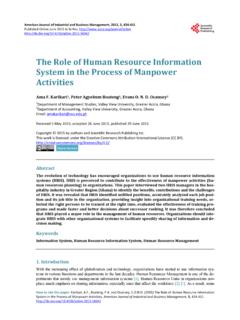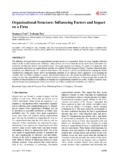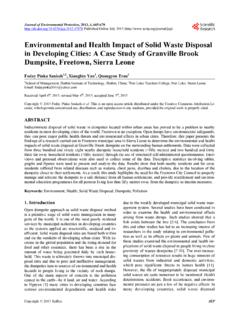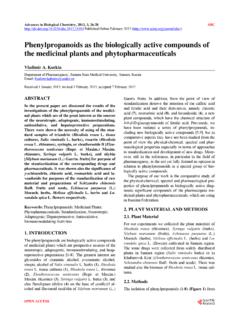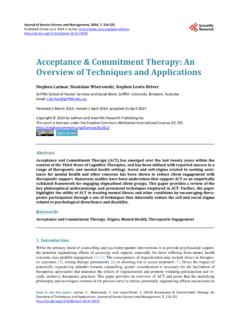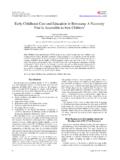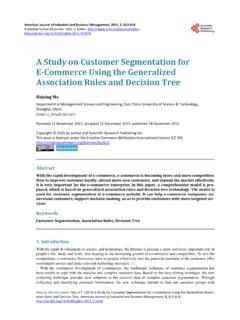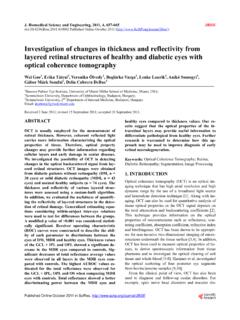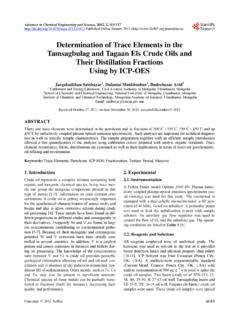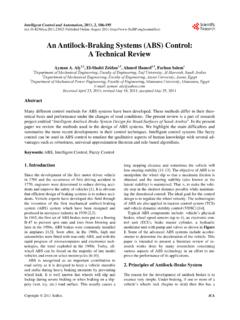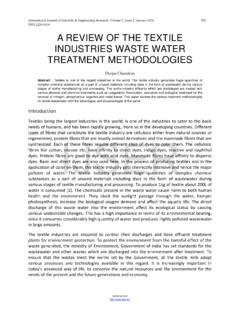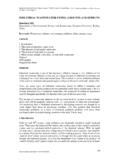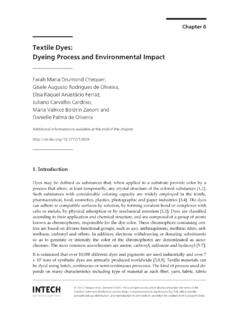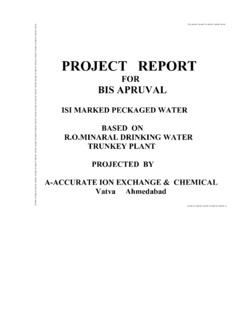Transcription of Textile dyeing industry an environmental hazard
1 , , 22-26 (2012) Natural Science Textile dyeing industry an environmental hazard Rita Kant University Institute of Fashion Technology, Panjab University, Chandigarh, India; Received 9 December 2011; revised 28 December 2011; accepted 14 January 2012 ABSTRACT color is the main attraction of any fabric. No mat- ter how excellent its constitution, if unsuitably colored it is bound to be a failure as a commercial fabric. Manufacture and use of synthetic dyes for fabric dyeing has therefore become a massive industry today. In fact the art of applying color to fabric has been known to mankind since 3500 BC. WH Perkins in 1856 discovered the use of syn- thetic dyes.
2 Synthetic dyes have provided a wide range of colorfast, bright hues. However their toxic nature has become a cause of grave con- cern to environmentalists. Use of synthetic dyes has an adverse effect on all forms of life. Pres- ence of sulphur, naphthol, vat dyes, nitrates, ac- etic acid, soaps, enzymes chromium compounds and heavy metals like copper, arsenic, lead, cad- mium, mercury, nickel, and cobalt and certain auxiliary chemicals all collectively make the te- xtile effluent highly toxic. Other harmful chem- icals present in the water may be formaldehyde based dye fixing agents, chlorinated stain remo- vers, hydro carbon based softeners, non bio deg- radable dyeing chemicals.
3 These organic mate- rials react with many disinfectants especially chl- orine and form by products (DBP S) that are often carcinogenic and therefore undesirable. Many of these show allergic reactions. The colloidal mat-ter present along with colors and oily scum in-creases the turbidity, gives the water a bad ap-pearance and foul smell and prevents the pene-tration of sunlight necessary for the process of photosynthesis. This in turn interferes with the Oxygen transfer mechanism at air water interface which in turn interferes with marine life and self purification process of water. This effluent if al-lowed to flow in the fields clogs the pores of the soil resulting in loss of soil productivity.
4 If allowed to flow in drains and rivers it effects the quality of drinking water in hand pumps making it unfit for human consumption. It is important to remove these pollutants from the waste waters before their final disposal. Keywords: Waste Water; Pollutants; Toxic; hazard ; Carcinogenic 1. INTRODUCTION color the earth beautiful and kill it with sweet poison!! The art of color application to enhance our self appe- arance and the world around us has been known to man since time immemorial. Historical records of the use of natural dyes extracted from vegetables, fruits, flowers, certain insects and fish dating back to 3500 BC have been found.
5 color is the main attraction of any fabric. No matter how excellent its constitution, if unsuitably colored it is bound to be a failure as a commercial product. Fabric was earlier being dyed with natural dyes. These however gave a limited and a dull range of colors. Besides, they showed low color fastness when exposed to washing and sunlight. As a result they needed a mordant to form a dye complex to fix the fiber and dye together thus making the dyers work tedious. The discovery of synthetic dyes by W. H. Perkins in 1856 has provided a wide range of dyes that are color fast and come in a wider color range and brighter shades [1]. As a result dye application has become a massive industry today.
6 However, due to the toxic nature and adverse effect of synthetic dyes on all forms of life the interest in natural dyes has revived throughout the world. Nevertheless even the natural dyes are rarely low-impact, due to cer- tain mordants that have to be used with them. Mordants, are substances, (such as chromium), used to fix color onto the fabric. They may be are very toxic and may have a high impact on the wastewater quality. Natural dyestuffs require large quantities of water for dyeing . (Almost equal to or double that of the fiber s own wei- ght). About 80 percent of the dyestuffs stay on the fabric, while the rest go down the drain.
7 Consequently natural dyes prepared from wild plants and lichens can have a very high impact on the environment. 2. WATER CONSUMPTION IN Textile industry The Textile dyeing and finishing industry has created a huge pollution problem as it is one of the most chemi- Copyright 2012 SciRes. OPEN ACCESS R. Kant / Natural Science 4 (2012) 22-26 23cally intensive industries on earth, and the No. 1 polluter of clean water (after agriculture). More than 3600 indi- vidual Textile dyes are being manufactured by the Indus- try today. The industry is using more than 8000 chemi- cals in various processes of Textile manufacture including dyeing and printing.
8 A fraction of these are listed in Ta - ble 1. Many of these chemicals are poisonous and dam- aging to human health directly or indirectly. Large quanti- ties of water are required for Textile processing, dyeing and printing. The daily water consumption of an average sized Textile mill having a production of about 8000 kg of fabric per day is about million liters. 16% of this is consumed in dyeing and 8% in printing. Specific water consumption for dyeing varies from 30 - 50 liters per kg of cloth depending on the type of dye used. The overall water consumption of yarn dyeing is about 60 liters per kg of yarn. dyeing section contributes to 15% - 20% of the total waste water flow.
9 Water is also required for washing the dyed and printed fabric and yarn to achieve washing fastness and bright backgrounds. Washing agents like caustic soda based soaps; enzymes etc. are used for the purpose. This removes the surplus color and paste from the substrate. Water is also needed for cleaning the printing machines to remove loose color paste from print-ing blankets, printing screens and dyeing vessels [3,4]. It takes about 500 gallons of water to produce enough fabric to cover one sofa. The World Bank estimates that 17 to 20 percent of industrial water pollution comes from Textile dyeing and finishing treatment given to fabric. Some 72 toxic chemicals have been identified in water solely from Textile dyeing , 30 of which cannot be removed5.
10 This represents an appalling environmental problem for the clothing and Textile manufacturers. Table 1. Major chemicals and dyes used in synthetic Textile mills [2]. Sr No. Chemical Quantity Kg/month1 Acetic Acid 1611 2 Ammonium Sulphate 858 3 P V Acetate 954 4 Wetting Agent 125 5 Caustic Soda 6212 6 Softener 856
